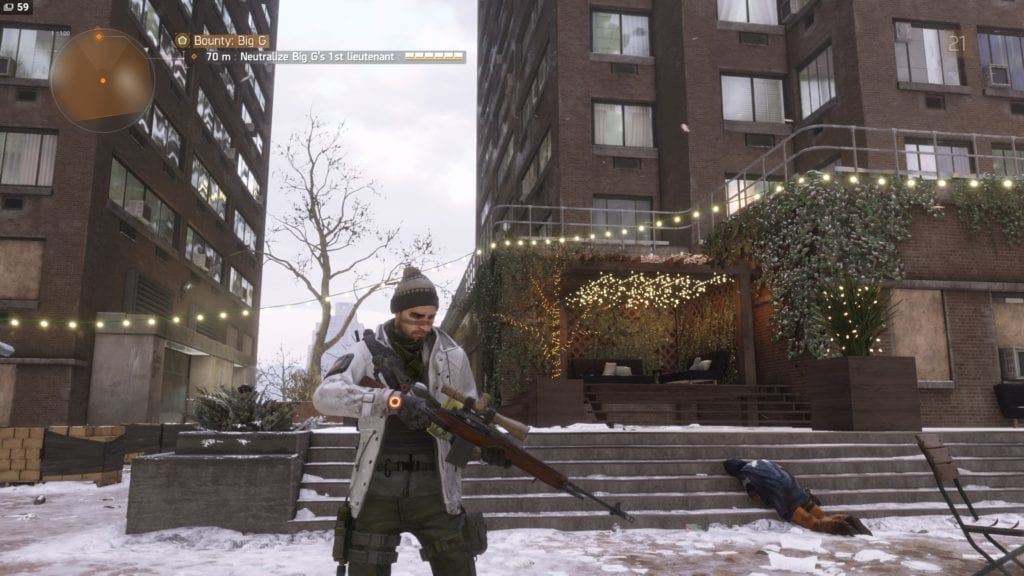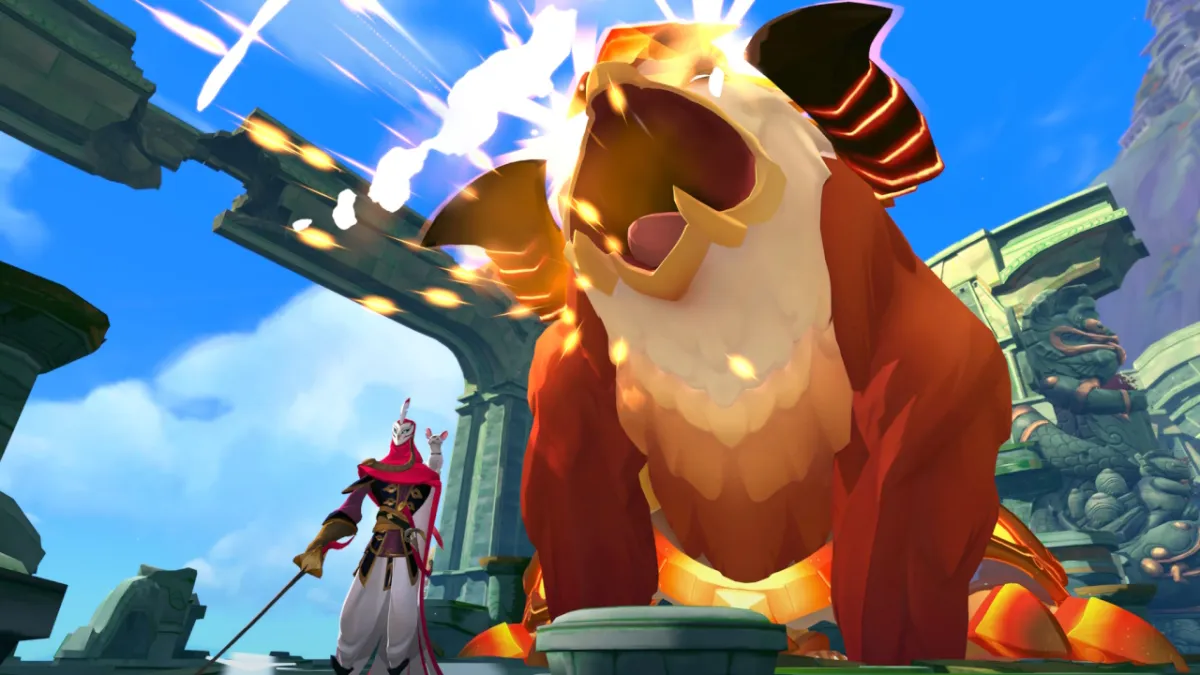The Division is an apt title for Ubisoft’s Clancy-branded attempt to occupy similar loot-driven shooter territory to Bungie’s Destiny. It’s a title which feels divided in several ways, but the clearest chasm is between the game’s attempts to portray the serious, harrowing aftermath of a fictional viral outbreak in New York (specifically, Manhattan), and its pervasive need to lay the groundwork for an ongoing, MMO-inspired, ‘game-as-service’ process.
Or, to put it another way, the dichotomy of a narrative based around gunning down as many violent looters and extrajudicial power-grabbers as possible, in preparation for a post-story loop of seeking individual power through the constant, violent acquisition of loot. If that was intentional meta-commentary on Ubisoft Massive’s part, then it’s quite ingenious. If not, it’s still darkly funny.

Crumbling, death-ridden, filthy New York has rarely been rendered more beautifully.
In The Division, you play a recently activated agent from a US sleeper cell of forces who hang around living normal lives until a catastrophic natural disaster occurs. When it does, Directive 51 kicks in and this ‘Division’ springs into action to maintain the continuity of the federal government by any means necessary. Manhattan has fallen into chaos and misery following the Black Friday outbreak of an engineered virus spread on bank notes (one of a couple of cursory nods towards the antagonist being anti-consumerist, which don’t really amount to much), and you’re part of the second wave of Division operatives being sent in to restore order.
Neither the first wave, nor the Joint Task Force (JTF) of local government and military personnel, could get things under control. It’s now down to a handful of agents, with a handful of faces between them (I went for the one that looks a bit like Tom Hardy and gave him a butterfly tattoo – it’s a shame the customisation isn’t broader), to get the job done with an awful lot of third-person cover shooting.
The nature of this premise immediately puts the player on dodgy moral ground, exercising secretive political power to kill in the name of restoring federal authority. Though, to emphasise the game’s odd duality, it’s more likely to be in the name of obtaining a sweet new bobble hat.

Make that a sweet new bobble hat and a shitload of weed.
In their defense, it seems enough people writing on The Division realised they needed to smooth off some of the authoritarian edges with convenient in-fiction explanations. What can, on the surface, appear to be a murder-thon through foes born of extreme mob-rule anxieties (rioters, escaped prisoners, paramilitaries and, in a Clancy-tastic retro homage to Red Scares of the 1950s, municipal sanitation unions) is at least slightly mitigated by expository dialogue, found footage, and environmental cues. Overheard radio chatter is explicit in stating that, although most of the people imprisoned at Rikers were there on bullshit drug possession charges, the ones banding together now are definitely just the more openly psychotic ones.
The Division themselves don’t come out looking too great either. Early on, the NPC associated with your tech department has a pointed monologue about the dubious legislative foundations of the organisation. By the time the game’s done, it’s clear that this method of disaster-intervention needs a serious re-think; despite what the player has achieved.
The route to that conclusion takes you through around 25-30 hours of third-person cover shooting based around RPG-like gear stats, and a spot of exploration in The Division’s open (albeit zoned by suggested player level) rendition of the districts of Manhattan.
This game does set-piece missions rather well, making the most of its city-in-crisis setting to usher players through shopping malls still decorated for Christmas, industrial power plants, and foreign consulate buildings. The internal lay-outs of these places make good use of their respective furnishings (jewelry kiosks, equipment palettes, fish tanks, and the like) to make it clear where it’s possible to take cover, without outright screaming “here are the inevitable waist-high things to hide behind”. Most of the larger locations will offer decent options for maneuvering into flanking positions (whether solo or in a co-op group), or taking higher ground. Moving between cover feels fluid too, although there will be instances where you’ll ‘stick’ to the wrong thing or find yourself unable to make the quick drop off a ledge you desire.

Blowing everything up counts as securing the area, right?
Despite a range of factions, enemy variety is not exactly bountiful. The flamethrower-owning ‘Cleaner’ group provide entertaining opportunities to target their fuel tanks, and certain boss characters (as well as grenade-lobbers) allow you to shoot at their ammo stash if you can engineer a clear shot. Beyond that, the selection is largely limited to the guys who rush you (melee weapons, shotguns), the mid-range assault rifle types, grenadiers, and reliably irritating snipers.
Later, some more technically minded chaps appear, able to do things like set up static turrets and create ‘heal zones’ (similar to options available to your own agent). But it feels a little late for the main campaign, as if they’re more of a transitional phase between the story missions and post-game challenges.
As well as your looted guns, each Division agent can deploy a pair of skills from the trio of Medical, Security and Tech trees. A third, powerful, signature skill can eventually be added to this selection, and the various damage-boosting cover devices, seeker mines, remote bombs, and ballistic shields are further augmented by passive talents and perks (gradually unlocked by rebuilding parts of your main base of operation). There’s also a collection of grenades and one-off consumables at your disposal; each one useful for a specific tactical situation, such as dealing with the thoroughly armoured bosses.

It’s … it’s not what it looks like, okay?
The Division, like Destiny and Warframe before it, is from the RPG numbers school of shooting, which means fully armoured bosses will happily take a couple of dozen shots to the head before going down (possibly more if they’re buffed by a co-op run). The AI mostly sticks to its roles pretty well (especially the Rikers and Last Man Battalion military factions), meaning it will try to sneak shotgunners around your flanks, get you out of cover with grenades, and generally keep the pressure on. Occasionally a random soldier or boss will have a mini freak-out and do absolutely nothing while you shoot them to pieces, but it’s worth just taking that as a freebie.
Late-game missions can be demanding to play solo, due to the sheer number of sniper-plus-another-guy elite and boss enemies The Division can throw at you. It requires deft use of cover, a solid healing ability, and weaponry that can deal significant damage in a short space of time. Plus any AI exploitation you can manage. When played in co-op, far more enemies fall under the elite, armoured category, but you’ve at least got several other people to help draw fire and (ideally) use some of the many group-focused skills and abilities in the game. It’s also easier to get someone around the back to sneak in some shots at a distracted sub-machine gun boss’s ammo pack.
The Division is an always-online title, which can bring latency problems. It’s a semi-regular occurrence to see damage registering on an enemy a good half second or so after you’ve taken a shot, though the one time (in 30-odd hours) the game outright dumped me back to the menu, it did load straight back up to the same location. Co-op matchmaking, at least, is fairly straightforward, with the smart inclusion of a matchmaking search at the very start of every major mission.

Thanks buddy.
Ubisoft clearly intend this title to be a long-haul affair, with regular updates and hooks (plus a full set of ‘season pass’ bumph) to keep the initial audience returning. But while the third-person shooting almost manages to sustain itself across the main, set-piece missions, it ends up feeling pretty wearing and rote. Manhattan’s side-quests in particular are (with a few more crafted exceptions) repetitive defend-this-area-rescue-this-guy set-ups, which even directly recycle dialogue. That’s when the JTF allies even remember who they’re supposed to be fighting, as they often seem concerned about flamethrowers even when the Cleaners are nowhere to be seen.
You have to do a fair number of these side bits just to keep up with the required amount of experience points (and, thus, the gear you can use) for the later story missions, and during these periods the game veers hard into stat-and-gear-grinding mode. The Safe House NPCs who give out some of these quests appear to have been beamed in from the Goofy MMO version of The Division, and are tonally completely at odds with much of the rest of the game. One minute you’re seeing genuinely terrifying footage of people being ambushed in a subway, the next a terrible pastiche of a New Age Spiritualist is clowning on aligning chakras to get some telecommunications running again. It’s bizarre stuff, almost all poorly written, and undermines what little convincing atmosphere is generated by the main plot.
Most of the title’s more poignant moments are the result of strong environmental design; a family dog wandering around confused and half-feral in the snow, or an act of humanitarianism captured on one of the collectible, scene-reconstructing ‘echoes’ dotted around the city. The most effective, and subtle indication that you may actually be doing Good Work™ is the way your main Post Office base slowly transforms from dilapidated shell to a functioning building, complete with seating areas, impromptu movie theaters, and other signs of society getting back on its collective feet. When The Division tries to get more heavy-handed with these moments of sadness or horror, it usually botches them. Like the Joker-esque acts of ironic torture against JTF staff that you see dotted around the Rikers home base, which feel like they went missing from a previous Arkham: Subtitle release.

“Sorry Batman, sometimes I just go a little hog wild … ahahaHOOO!!”
These inconsistencies are likely, in part, down to the way large developers have to delegate writing tasks. But they’re also inherent to the construction of a game which is trying to pull in several different directions (serious narrative, open world collect-a-thon, stat-driven RPG shooter, long-term MMO-influenced multiplayer title), and finding it extremely difficult to unify theme with mechanics. The confused political thrust of the game, intentionally or not, ends up mirroring the chaotic situation presented at its fictional heart, but the themes presented rarely have much depth. The Division uses catastrophe as pure set-dressing; an elaborate (and arguably necessary), excuse to justify the whack-a-mole loot collection that’s a given in fantasy or sci-fi settings.
Loot drives all in this game. Keeping up with The Division’s treadmill of enemies means cycling through the grey, green, blue, purple and yellow/gold (in order of quality) items they periodically drop, and figuring out which pieces of gear work best for your character. There’s some significant aRPG-style depth to this, as each pair of gloves, or new AK-47 will come with additional bonuses and quirks, and can be modded further with additional pick-ups. The game has no shortage of ways to nudge your stats and boosts in various directions, nor does it lack for methods (vendor, crafting, looting) of acquisition.
Here, again, the game’s setting works somewhat against it. Those familiar with gun models might get some interest out of weaponry with names like Military M4A-9.7-D27, but surely nobody is getting too excited about switching out holsters or knee pads with few distinguishing features beyond their pure stats. There’s an undeniable early thrill at finding purple and yellow items for the first time, yet it’s also a feeling with diminishing returns and an unpleasant whiff of the slot machine.
Figuring out those specific stat changes is actually rendered pretty tricky by a persistent bug that seems to prevent attribute-based gear changes from displaying correctly on the character screen without a restart. An ‘undo’ button for mistaken sales and item deconstruction would be welcome too, as it’s all too easy on the PC interface to accidentally lose something useful. The PC version, incidentally (and for those who missed the prior piece), is technically pretty solid and very customisable.

Looks real pretty an’ all. Also, since I forgot to mention it in the text: the voice of your comms computer is Garrus from Mass Effect. So that’s cool.
Theme and mechanics do eventually manage some commendable convergence, if only in concept, in the potential competitive multiplayer arena of the Dark Zone. This walled-off section of Manhattan, too virus-ridden for all but the bravest or most foolhardy, is a clever combination of premise, theme (Division agents potentially going rogue in a grasp for power), and third-person shootin-n-lootin’. It’s also a troubled area at present, veering between the tense, vicious space with potentially high rewards (which it still feels like at earlier player levels), and focus of ire for the post-game players who (rightly) argue that there’s currently very little incentive for them to ‘go rogue’ and shoot fellow Division agents. Both are accurate portrayals, which indicates that the Dark Zone will require some developer babysitting to avoid a slow slide from captivating to irrelevance.
A less damning statement could be directed at The Division itself. As the game’s player-base move to expect continual gratification from the post-game grind, and the title’s story and setting fade even further into the background, Massive will need to deliver a steady drip-feed of activities. If Destiny is any indication, this could be a rather different game by the close of 2016. As we get further from release, the question becomes less about whether The Division is any good, but whether it can retain the large loot-driven audience it has evidently gained.
The Division never really manages to reconcile the differences between its super-serious, speculative virus fiction and the thoroughly videogame antics of murdering a man named Bullet King over and over again in the name of farming currency and materials, but for those hooked on the latter this probably won’t register as a concern. It’s a game, appropriately, of divides, between solo and social, narrative and numbers, themes and mechanics. The former aspects are weaker in every case, but the latter, while often flawed and repetitive, are where the title should continue to infectiously thrive.




